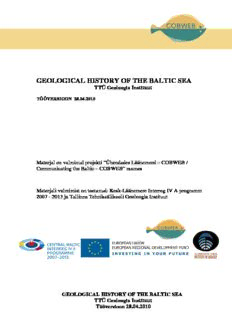
geological history of the baltic sea PDF
Preview geological history of the baltic sea
GEOLOGICAL HISTORY OF THE BALTIC SEA TTÜ Geoloogia Instituut TÖÖVERSIOON 28.04.2010 Materjal on valminud projekti “Ühendades Läänemerd – COBWEB / Communicating the Baltic – COBWEB” raames Materjali valmimist on toetanud: Kesk-Läänemere Interreg IV A programm 2007 - 2013 ja Tallinna Tehnikaülikooli Geoloogia Instituut GEOLOGICAL HISTORY OF THE BALTIC SEA TTÜ Geoloogia Instituut Tööversioon 28.04.2010 1. Introduction 2. Location of the Baltic Sea TOPOKAART LISADA The Baltic Sea is a brackish inland sea located in Northern Europe, from 53°N to 66°N latitude and from 20°E to 26°E longitude. It is bounded by the Scandinavian Peninsula, the mainland of Europe, and the Danish islands. It drains into the Kattegat by way of the Øresund, the Great Belt and the Little Belt. The Kattegat continues through Skagerrak into the North Sea and the Atlantic Ocean. The Baltic Sea is connected by man-made waterways to the White Sea via the White Sea Canal, and to the North Sea via the Kiel Canal. The Baltic Sea might be considered to be bordered on its northern edge by the Gulf of Bothnia, on its northeastern edge by the Gulf of Finland, and on its eastern edge by the Gulf of Riga. However, these various gulfs can be considered to be simply offshoots of the Baltic Sea, and therefore parts of it. GEOLOGICAL HISTORY OF THE BALTIC SEA TTÜ Geoloogia Instituut Tööversioon 28.04.2010 3. INTRODUCTION The Baltic catchment area Watersheds of rivers falling into the Baltic Sea outline the present contours of the gentle topographic depression surrounding the sea. Watersheds correspond to Scandinavian Mountain chain in NW, Maanselkä hilly chain in NE, and Valdai and Belarus hills in SE. The catchment area is a depression around the Baltic Sea - the Baltic Depression sensu lato – BD. The Baltic Ice Lake (BIL) flooded the major lower area of BD. The area in contours of BIL has gradually emerged from the ice lake and, in the contours of the Yoldia Sea, from the sea. These emerged areas have been called as “virgin lands”. Thus, the new-born Baltic waterbody was much larger and deeper than present BS. GEOLOGICAL HISTORY OF THE BALTIC SEA TTÜ Geoloogia Instituut Tööversioon 28.04.2010 4. Deep crustal roots of BD JOONIS LISADA The Baltic depression as a major morphostructure of the East European Craton (EEC) separated from the surrounding basins of great rivers White Sea, Arctic Ocean, Caspian Sea and Black Sea catchment areas in Early Cenozoic. NE and SE watersheds of the Batic cathment area follow the rifted and faulted boundaries of the 2 Bill years old Paleoproterozoic Svecofennian Crustal Domain. The interior of BD nestled upon the Svecofennian domain suggesting that differentiated tectonic movements of this domain favoured for the erosion of its central area and forming the depression opened to the SE border of EEC. GEOLOGICAL HISTORY OF THE BALTIC SEA TTÜ Geoloogia Instituut Tööversioon 28.04.2010 5. THE GERAT ICE AGE, WAISTAGE OF GLACIERS AND BIRTH OF BIL Late Cenozoic glaciations following the global cooling epochs Oxygen isotope ratios in deep ocean sediments, especially in fossil sceleton reflect seawater temperature changes. Studies reveal that over 20 stages of minor and major glaciation events occurred since the continental glaciations started in northern hemisphere at about 2.6 M years ago. TABELIST EEMALDADA MAGNET-STRATIGR GEOLOGICAL HISTORY OF THE BALTIC SEA TTÜ Geoloogia Instituut Tööversioon 28.04.2010 GEOLOGICAL HISTORY OF THE BALTIC SEA TTÜ Geoloogia Instituut Tööversioon 28.04.2010 6. The Great Ice Age – Pleistocene Glaciation – a principal foreplay towards the Baltic Sea, its general and local features An artist's impression of Ice age Earth at glacial maximum. Based on: "Ice age terrestrial carbon changes revisited" by Thomas J. Crowley. The great Ice Age – Pleistocene Glaciation - started 1.6 million years ago, causing widespread glaciation on northern continents. It was a period of global temperature reduction. In human history, this prehistoric era is commonly referred to as Paleolithic. Fennoscandia and surroundings were covered by an ice sheet then. GEOLOGICAL HISTORY OF THE BALTIC SEA TTÜ Geoloogia Instituut Tööversioon 28.04.2010 7. A scientists` view to maximum glacial extent 1.5 Million years ago The Baltic, Hudson and White seas shown in blue were actually overfilled with ice 2-3 km thick. High ice plateaus of the Northern Hemisphere towered above the surrounding lowlands and ocean, the level of the last lowered some xxx m. Under the ice sheet, the solid land surface had subsided some 200-300 m or more below its pre-glacial level. GEOLOGICAL HISTORY OF THE BALTIC SEA TTÜ Geoloogia Instituut Tööversioon 28.04.2010 8. Modeling of changes in territorial extent of the ice sheet from Eemian through Weichselian to Holocene The largest ice sheet 5.5 M km2 covered lowlands and shelf seas around Fennoscandia. It towered in Northern Europe during the Late Glacial Maximum (LGL) Late Weichselian at about 25 to 15 thousand years ago. During the Weichselian, usually less than 2 000 km2 of the territory was covered with ice. GEOLOGICAL HISTORY OF THE BALTIC SEA TTÜ Geoloogia Instituut Tööversioon 28.04.2010 9. Eeamian Sea The ocean level during the Eemian interglacial, about 130-115 thousand years ago was ~2-5 m higher than any time during Holocene that left Scandinavia an island. The Eemian sea level flooded low areas including land bridges between the Gulf of Finland and White Sea. This precursor was larger than the present Baltic and obviously of higher salinity. JOONIS LK http://notendur.hi.is/oi/Historical%20Geology%20pdf/Fyrirlestur%2014%20- %20Pleistocene%20glaciations.pdf GEOLOGICAL HISTORY OF THE BALTIC SEA TTÜ Geoloogia Instituut Tööversioon 28.04.2010
Description: